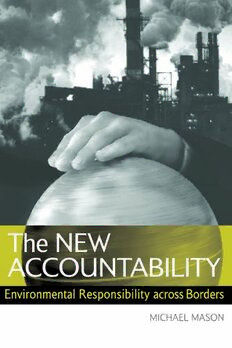Table Of ContentThe New Accountability:
Environmental Responsibility
Across Borders
The New Accountability:
Environmental Responsibility
Across Borders
(cid:1)
Michael Mason
London (cid:1) Sterling, VA
FirstpublishedbyEarthscanintheUKandUSAin 2005
Copyright(cid:1)MichaelMason,2005
Allrightsreserved
ISBN:1-84407-067paperback
1-84407-066-2hardback
TypesettingbyTWTypesetting,Plymouth,Devon
Printedandboundin theUKby CromwellPressLtd,Trowbridge
CoverdesignbyYvonneBooth
For afulllistofpublicationspleasecontact:
Earthscan
8–12CamdenHighStreet
London,NW10JH,UK
Tel:(cid:1)44(0)20 73878558
Fax:(cid:1)44(0)2073878998
Email:earthinfo(cid:2)earthscan.co.uk
Web:www.earthscan.co.uk
22883QuicksilverDrive,Sterling,VA20166-2012,USA
EarthscanisanimprintofJamesandJames(SciencePublishers)Ltdandpublishesinassociation
withtheInternationalInstituteforEnvironmentandDevelopment
Acataloguerecordforthisbookis availablefrom theBritishLibrary
LibraryofCongressCataloging-in-PublicationData
Mason,Michael,1966–
TheNewAccountability:environmentalresponsibilityacrossborders.MichaelR.Mason
p.cm.
Includesbibliographicalreferencesandindex
ISBN1-84407-067-0(pbk)–ISBN1-84407-066-2(hardback)
1.Environmentalprotection–Internationalcooperation.2.Environmental
policy–Internationalcooperation.3.Environmentalresponsibility.I. Title.
JZ1324.M372005
333.7–dc22
2004024814
Printedonelementalchlorine-freepaper
For Witchuda Damnoenyut
Contents
Preface ix
Figure and Tables xiii
Acronyms and Abbreviations xv
Introduction 1
1 Transnational Accountability for Environmental Harm:
A Framework 16
2 Advocates for Environmental Accountability: Activist Groups,
Networks and Movements 41
3 Citizenship Beyond National Borders? Affected Publics and
International Environmental (cid:1)egimes 67
4 The World Trade (cid:1)egime and Environmental Accountability 88
5 Transnational Liability for Environmental Damage 113
6 The Environmental Accountability of Transnational
Corporations 144
Conclusion 167
(cid:1)eferences 179
Index 197
Preface
In contemporary debates about democratic governance, the concept of
accountability is hard to avoid. At least from a European perspective, recent
innovations in political and administrative decision-making have multiplied
opportunitiesfor citizens to hold to accountthose whoexercisegovernmental
authority. Or so we are told. Whether busy modernizing constitutional
structures or realigning public services along market-led lines, our political
representatives have proclaimed a new era of open and responsive govern-
ment. Accountability, in these terms, denotes enhanced processes of public
oversight and answerability for decision-making involving political authority.
In practice it has seen the emergence of an audit culture in which
administrative efficiency and service delivery targets are paramount – where
citizens become clients and public officials become managers. Nevertheless, it
has not been easy to shake off the core political dimension of accountability –
that decisions made in our name can be discussed and challenged.
As I write this preface in London, as arguments persist about the legal basis
onwhichmycountrywenttowarinIraq,andascivilianandmilitarycasualties
rise further, the UK Government mantra of policy transparency sounds
particularly hollow. When the United Nations Secretary General Kofi Annan
statesthat the invasionof Iraqwas notin conformitywith the UnitedNations
Charter,Iamexpectingsomethingmorefrommygovernmentthanthegiving
of (shifting) reasons, something more than a series of quasi-judicial reviews
bluntedin theirmandatesand powers.Actions takingplacein thenameof the
British people are profoundly altering the lives and living conditions of
countless others. And these actions are claimed by the UK and US
administrationsto be motivated,as least in part, by their desire to introduceto
Iraq a constitutional system subscribing to principles of democratic accounta-
bility. By ignoring international legal constraints on the use of military force
anddomesticallycurtailingcivilliberties,thesegovernmentshaveexposedhow
fragile webs of accountability can be. Moreover, the intimate involvement of
major transnational companies (such as Bechtel and Halliburton) in the
decisions moulding the future of Iraq has also shown how arbitrary it is to
exclude private corporations from issues of accountability to affected publics.
x The New Accountability
This book is preoccupied with overcoming the tendency to think about
accountability as only taking place within state borders and only featuring
governmental actors. Looking above all at transboundary flows of pollution,
its central claim is that processes of public answerability for harm rest most
justly on treating all victims (real or potential) with equal respect. That means
that both state and non-state producers of significant harm have a moral
obligation effectively to consider the interests of all affected parties, whether
these parties are fellow co-nationals or foreigners. In the study I employ a
non-territorialnotionofthe‘public’tobreakawayfromtheideathatweneed
only worry about the harm we cause to those immediately around us (both in
space and time). Environmental responsibility – that is, accountability claims
entailing claims to redress as well as answerability – should be established in
open public discussions about harm and risk, where affected publics become
collectivelyawareofharmreceivedasbeingattributabletoparticulardecisions
or policies. The question of redress, of effective regulatory controls, is crucial
to realizing what I label this new (non-territorial) accountability. And in the
book I try and show how new accountability norms are informing the
campaigning of transnational activist networks and also starting to feature in
international environmental regimes. These accountability norms feed into,
and are bolstered by, transnational spaces of public communication. In
mapping out shared pathways of social and ecological harm, transnational
publics cannot avoid thinking about alternative futures.
I want to thank all those who have helped shape my thoughts on these
issues, however much this book falls short of the understanding they would
likely have forged tackling the same subject matter. At the London School of
Economics I have learnt much from discussions and seminars with colleagues
in the Departmentof Geographyand Environment, notably my ‘environment
cluster’ colleagues – Giles Atkinson, Andy Gouldson, David Jones, Eric
Neumayer, Tim Rayner, Judith Rees and Yvonne Rydin. I am much
indebted to the Earthscan referees who took time to offer careful, considered
feedbackonearlierversionsofthis manuscript.Various partsofthebookhave
also benefited from the comments and suggestions of Andy Dobson, Andrew
Linklater,BryanNorton,RichardPerkinsandDerekWall:mythankstothem
all. Chapter 4 features research funded by the British Academy under grant
number SG-34522 (2002–3): I acknowledge their valued support. Several
chapters have been reworked and revised from arguments first put forward in
academic articles: for Chapter 1 this was a paper published in Transactions of
the Institute of British Geographers (2001), Vol 26, No 4, pp407–29; for Chapter
4 this was a paper published in Environmental Politics (2004), Vol 13, No 3,
pp566–89; and for Chapter 5 this was an article that appeared in Marine Policy
(2003), Vol 21, No 2, pp77–98. I’m happy to acknowledge Blackwell
Publications, Taylor & Francis and Pergamon Press as the publishers of these
papers.Also, I thankProfessor RogerKaspersonforallowingme to reproduce
the transboundary risk classification figure in the Introduction: the work of
Preface xi
Jeanne and Roger Kasperson rightly holds a leading position in the field of
environmental risk management. Lastly, and by no means least, I would like
to thank Bill and Michelle Antrobus for so ably transforming my manuscript
into this book.
Michael Mason, November 2004.
Figure and Tables
Figure
1 A fourfold classification of transboundary risk 8
Tables
4.1 NGO satisfaction with 2001–2002 WTO briefings on CTE
negotiations 100
4.2 NGOs’ positions on WTO–civil society relations 101

